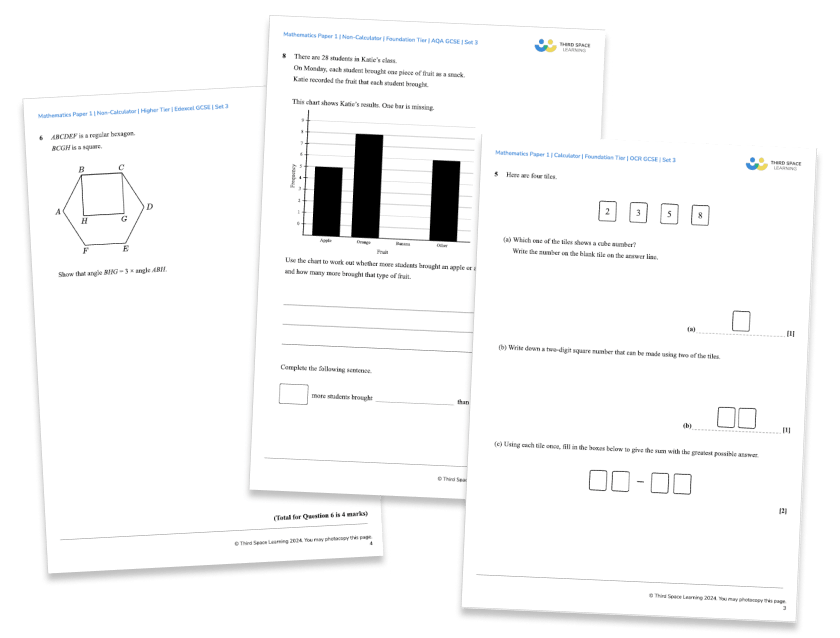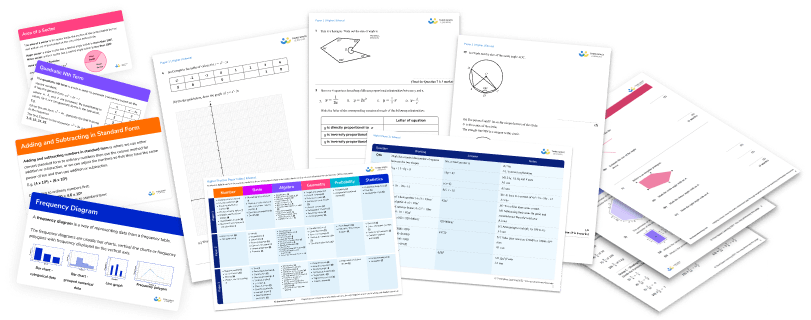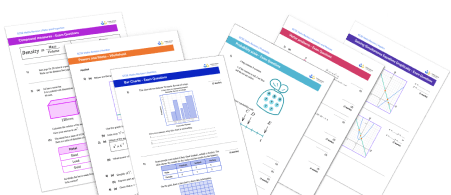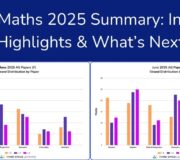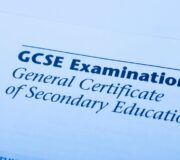What’s Next? Analysis of GCSE Maths Paper 1 Topics With Recommended Revision List For GCSE Maths Paper 2 and Paper 3 (2023)
Originally published Monday 22nd May 2023
Expert consultant and contributor Christine Norledge gives a detailed analysis of the GCSE maths Paper 1 topics this year from both the Foundation and Higher papers to provide key recommendations on what’s likely to come up on Papers 2 and 3. Includes a hit list of recommended topics to revise next.
We’re here again! It feels like five minutes since I sat down to analyse 2022’s summer GCSE papers, but another year has passed and another cohort have just sat their GCSE Maths Paper 1.
Last year’s exams felt a little unusual with advance information for each paper, but this year we are more or less back to normal – the only adaptation that has remained in 2023 is the provision of formulae sheets for GCSE maths, physics and combined science.
After each paper, I find it useful to go through and check off the topics that we’ve had, in order to provide students with a hit-list of areas to focus their revision for the next paper.
This blog is my analysis of the 2023 Foundation and Higher Paper 1, with some suggestions to support your students in preparing for the Paper 2 and Paper 3.
This blog focuses on the Edexcel papers, rather than AQA, OCR or IGCSE. It’s also specifically about GCSE mathematics, rather than any A Level exams.
Be aware that the analysis and recommendations that follow are my own interpretation of GCSE maths Paper 1, and are not endorsed in any way by Edexcel. The question papers and mark schemes are yet to be formally released.
GCSE MATHS 2026: STAY UP TO DATE
Join our email list to stay up to date with the latest news, revision lists and resources for GCSE maths 2026. We’re analysing each paper during the course of the 2026 GCSEs in order to identify the key topic areas to focus on for your revision.
GCSE dates 2026
GCSE results (2026 when available)
Get ahead on revision with the GCSE maths papers analysis from 2025:
Analysis of GCSE Maths Paper 1 2025
Analysis of GCSE Maths Paper 2 2025
GCSE Maths Paper Analysis and Summary 2025
GCSE Maths Teacher Survey Results 2025
- Hit list of revision recommendations for Edexcel Paper 2 & 3
- Foundation tier revision focus hitlist
- Higher tier revision focus list
- Data behind the revision focused hit lists for Paper 2 and Paper 3
- Student reactions to Maths Paper 1
- Process and terminology used in the analysis of Paper 1
- Detailed analysis of Maths Paper 1 Foundation 2023
- Detailed analysis of Maths Paper 1 Higher 2023
- What’s next? Preparing for Papers 2 and 3
- What’s next for your GCSE maths revision
- Addendum: Links to the free maths revision guides for all topics in the hit lists above
Stay updated for 2026 GCSE season
Join our email list to be alerted to any new changes to GCSE maths exams in 2026.
We’ve got all the GCSE dates 2026 and we will be reviewing the contents of each of the GCSE maths papers in 2026 and taking a good look at the GCSE results 2026 in August.
Hit list of revision recommendations for Edexcel Paper 2 & 3
Let’s start with the hit list of recommended revision priorities for Edexcel Paper 2 and Paper 3 and then move on to the analysis. But keep in mind that, to quote @justmaths on Twitter, “No one can predict what is going to come up”.
We’d all like to know what’s going to be on Paper 2 and 3 but we don’t. What we can do is make educated and informed guesses based on what is likely to come up. And that’s what follows.
Below are the two lists of topics I’d direct students towards to ensure that they can do confidently before the next two papers. These should be viewed as a suggested, incomplete list, not an exclusive prediction of the next two papers!
Foundation tier revision focus hitlist
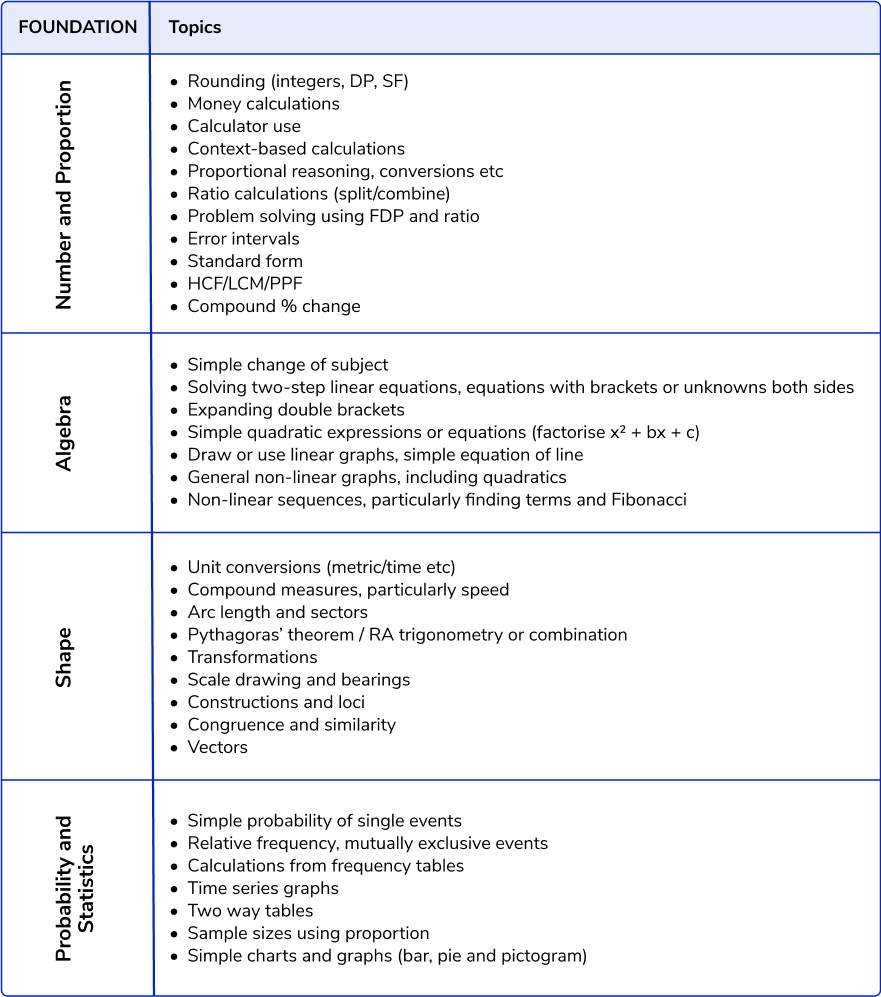
Higher tier revision focus list
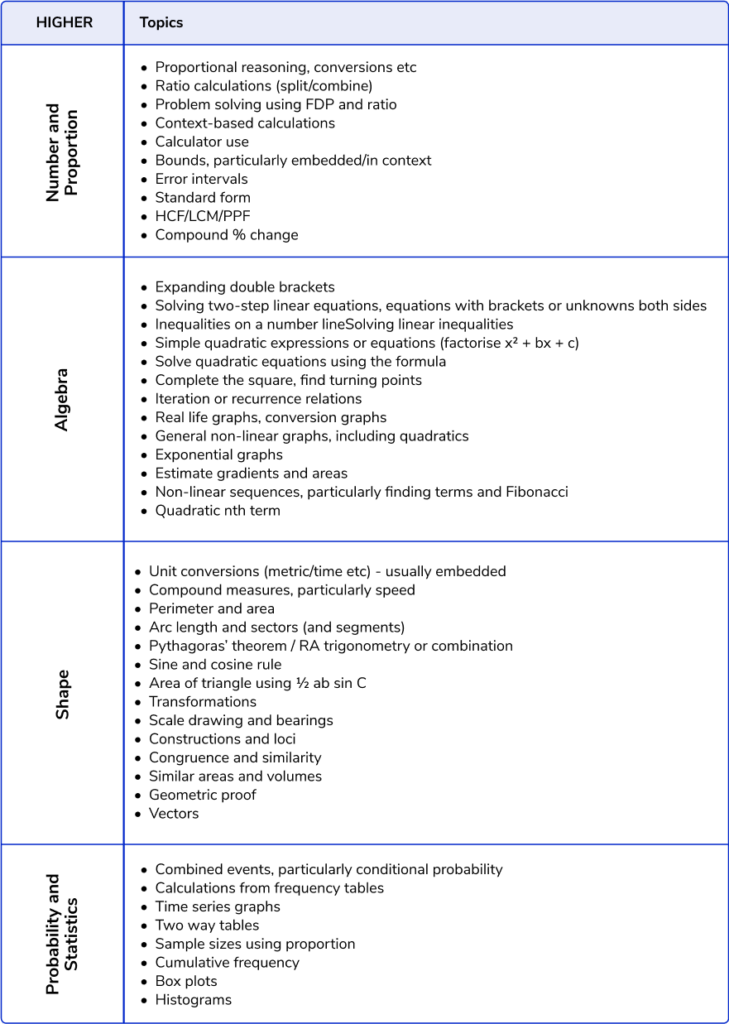
How best to share these revision recommendations
If you’re concerned that your students may ‘over-interpret’ this list, then consider sharing it with them in a different format. Using the Third Space Learning secondary maths resources library you will be able to create your own collection of practice exam questions targeting these top topics.
To make it easier for you we’ve already put together a free bundle that includes worksheets on the hit list topics. Each worksheet includes functional and applied reasoning questions, practice questions and exam style questions
At the end of this blog you’ll also find links to the specific GCSE maths revision resources, questions and worksheets you’ll need for each of the hit-list topics, which may be useful in producing revision resources along these lines for your students.
Paper 2 & Paper 3 Revision: GCSE Exam Questions & Worksheets
Based on the Edexcel GCSE Maths Exam 2023 Paper 1, this resource provides all of the worksheets that accompany our revision guides and correspond to the recommended revision priorities for Edexcel Paper 2 and Paper 3.
Download Free Now!Data behind the revision focused hit lists for Paper 2 and Paper 3
To create this list, I’ve used a combination of:
- Data from my analyses of previous June series of Foundation and Higher papers;
- Lists of topics that have more frequently appeared on calculator papers;
- Topics that are by necessity only assessed on the calculator papers;
- Topic lists from Paper 1 Foundation and Higher sat by students on 19th May.
For some topics that have already appeared, it is less likely (but not impossible!) that they will come up in subsequent papers – so for this series, that’s things like a tree diagram given in a question, or drawing a frequency polygon.
Some topics are so broad-reaching that they appear on two or more papers – for example, it’s almost guaranteed that there will be more proportional reasoning on one of the Foundation calculator papers, but this is unlikely to be another recipe problem.
For further detail and other suggested topics, please see the more detailed tables and analysis that follows.
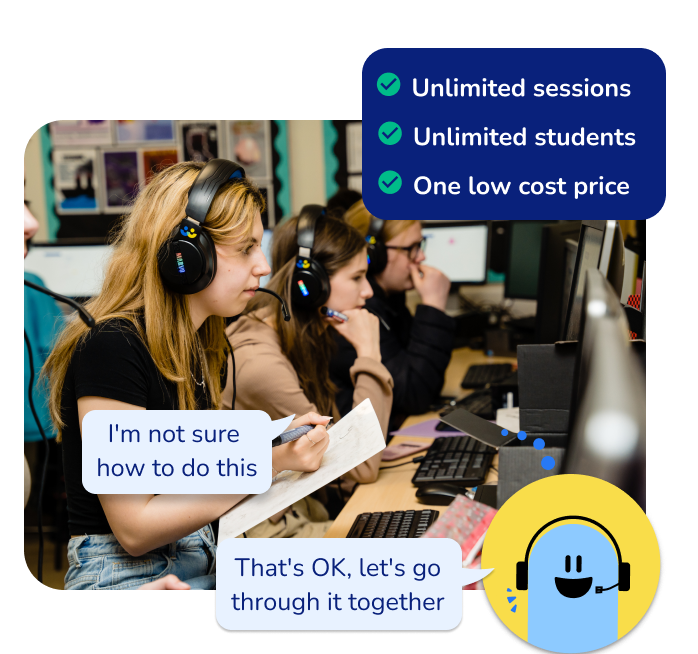
Unlimited GCSE maths tutoring with Skye, the voice-based AI maths tutor.
Built on the same principles, pedagogy and curriculum as our traditional tutoring but with more flexibility, reach and lower cost.
Help your GCSE students achieve their target grade with Skye’s one to one maths tutoring.
Watch Skye in actionStudent reactions to Maths Paper 1
Before we get into my analysis of Paper 1, let’s have a quick look at what this year’s cohort made of the papers.
As usual, students took to social media in their droves to offer their opinions and witty takes on Edexcel Foundation and Higher Paper 1.
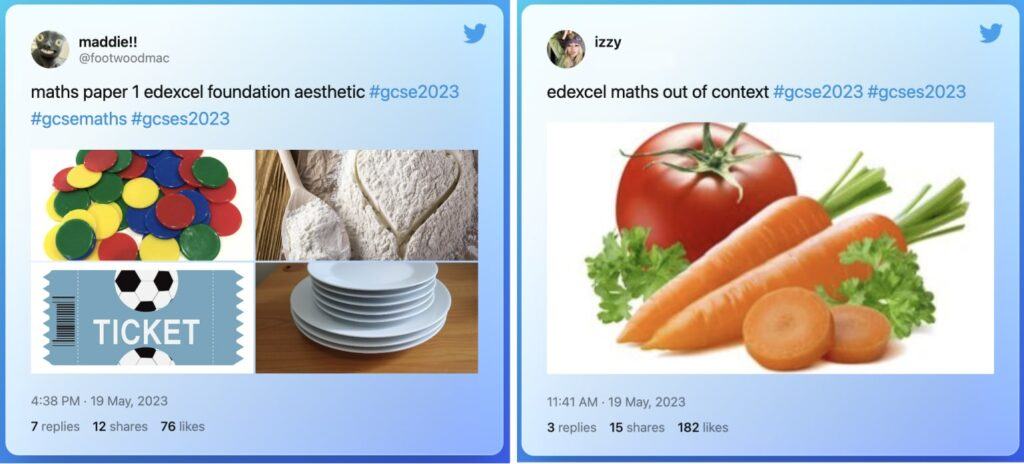
The ‘carrots and tomatoes’ question on the Higher got a lot of mentions – the easiest solution required students to write and solve a pair of simultaneous equations, but the sticking point for many was converting the second piece of information (given as a ratio) into a usable equation.
The division by a two-digit decimal upset a few people on Foundation and Higher…

…but generally the reaction to the papers were fairly positive from students, with a few having a really positive experience.
Now let’s look in more detail in the topics and questions we saw in the 2023 GCSE maths paper 1.
Process and terminology used in the analysis of Paper 1
In this blog, I’ve used the same processes and classifications as in my previous exam analysis blog posts:
- Question Level Analysis Of Edexcel Maths Past Papers (Foundation) (2017-2019)
- Question Level Analysis Of Edexcel GCSE Maths Higher Past Papers (2017-2019)
And 2022’s series of exam paper analysis blogs:
To summarise, I’ve gone through the paper and assigned a topic and strand to each question, noted the number of marks available and also given a ‘complexity’ score, which broadly aligns with the GCSE assessment objectives (see more below).
Topic classification used across all GCSE maths papers
Standard abbreviations are used as follows:
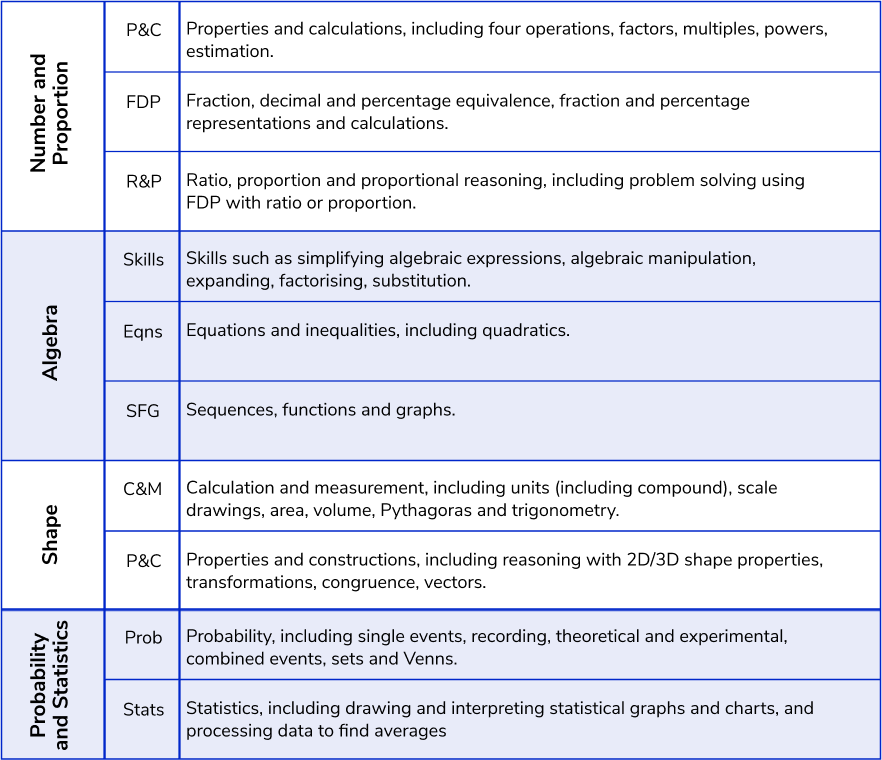
In order to simplify the analysis process, I have classified the high-mark problem-solving questions in the maths past papers by their main topic, or by the topic that’s required to access any of the marks on the question.
For example, I have classified the volume of a cylinder and pressure question that appears in the crossover content as primarily “volume of a cylinder”, as it’s difficult to do anything meaningful with the pressure/force/area formula unless the candidate can use volume and height to work backwards and calculate the base area.
This does lose a little bit of the detail, but makes it easier to look for trends across a larger data set.
Complexity classification used across all GCSE maths papers
| C1 | Standard procedural problems, often worth one or two marks |
| C2 | Problems asking candidates to explain their reasoning, interpret information from tables, diagrams or other contexts, or ‘show that’ type questions |
| C3 | Non-standard multi-step problems, often requiring the application of skills from a variety of topics, worth three, four, or more marks |
It should be noted that this is not a ‘difficulty’ measure – for example, ‘higher grade’ topics on each tier, such as simultaneous equations on Foundation tier or trigonometric graphs on Higher tier, are often examined as standard procedural. We can see examples from this year’s Paper 1 with frequency polygons and fraction calculations in the crossover content (i.e. top end of Foundation), and the 3D trigonometry question towards the end of the Higher paper.
The suggestions that follow are based on data analysis of the June 2017-2019 and 2022 exam papers (i.e. the ones that were actually sat by students) – this is four series of papers.
These are only ever going to be informed recommendations from me so I leave it of course to your professional judgement to decide on what to do with the information.
Detailed analysis of Maths Paper 1 Foundation 2023
This year’s Foundation Paper 1 felt generally fair and accessible, particularly given that this year’s cohort have had considerable disruption to learning time as a result of the pandemic. The paper started with some nice one-markers and ramped slowly in comparison with some previous papers – for example, Q11 involved students carrying out a simple subtraction in context for two marks, which seems quite generous.
Topic allocation in Maths Paper 1 (Foundation) 2023
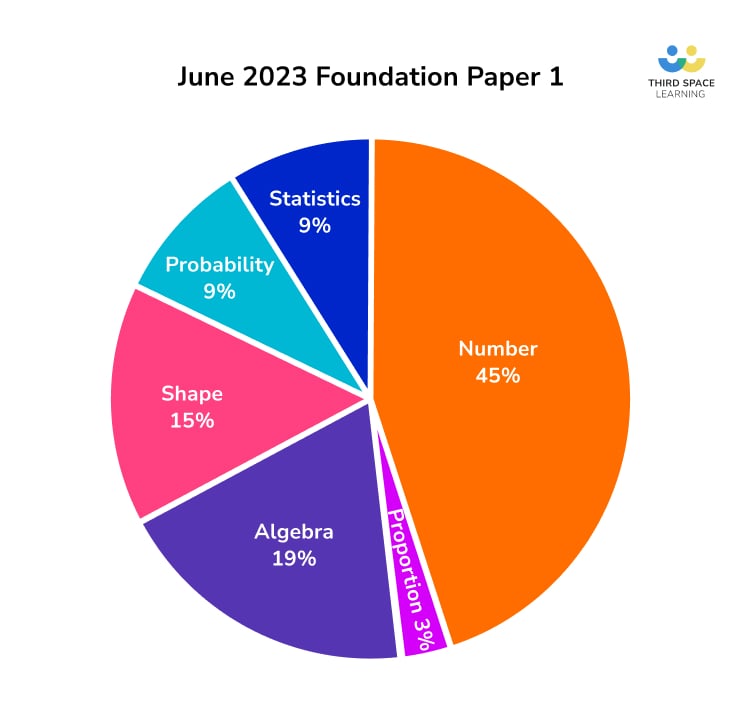
In the pre-crossover content, most questions were very straightforward, with limited sneaky bits for students to spot or be tripped up by. As is to be expected, some students reportedly struggled with the crossover volume of a cylinder/pressure question, but it’s worth noting that even this one only required students to use volume = area of cross section x length, rather than the full volume of a cylinder formula – both of which appear on the formula sheet.
Complexity of questions in Maths Paper 1 (Foundation) 2023 compared to previous years
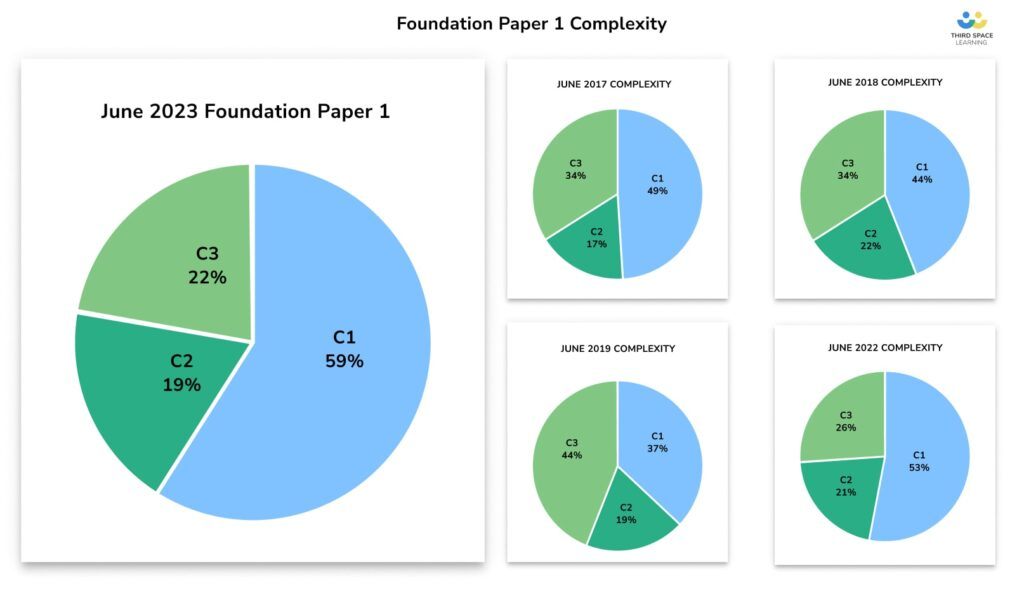
2023’s Paper 1 is proportionally similar in complexity to June 2022, which is to be expected given the disruption these cohorts have experienced. Nearly 60% of the paper was C1 (standard procedural) questions, reflective of the lack of “sneaky questions” or nuance to the way most questions were asked.
C2 content appears fairly consistent across summer series, with roughly 20% of the marks on the paper available for questions involving reasoning, interpreting charts or tables, reading and synthesising information.
2023’s paper has the lowest proportion of C3 questions of all the summer series so far – again, this is possibly deliberate on the part of the examiners to make allowances for the cohort.
Mark allocation for topics in Maths Paper 1 (Foundation) 2023 with comparison to previous years
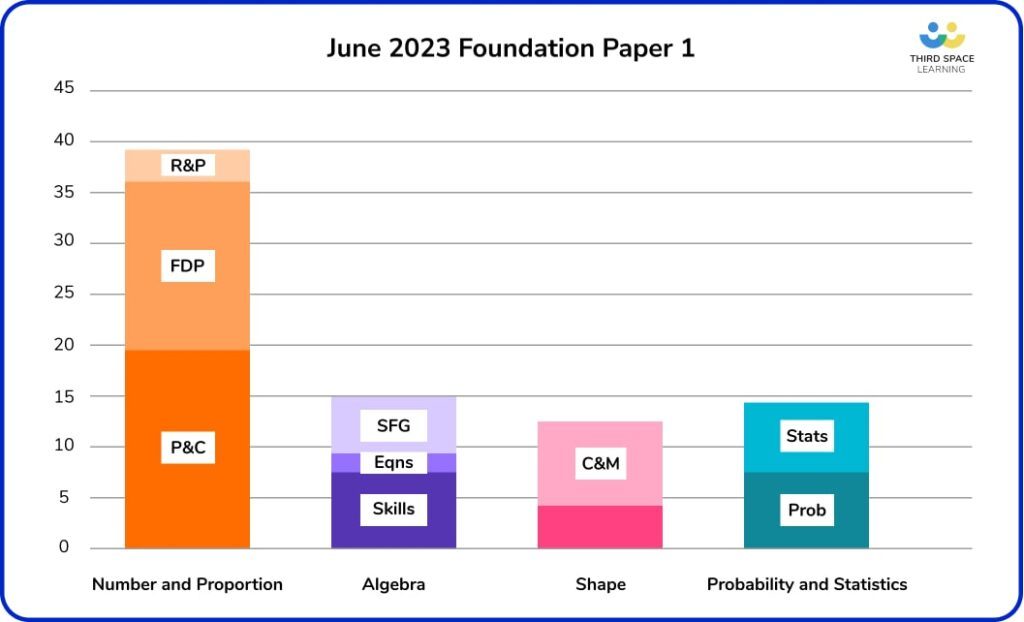
This paper has significantly more marks available for the Number strand and fewer for the Proportion strand than previous series, with very little on straight proportion or ratio questions.
As such, we can probably expect to see more on Papers 2 and 3, particularly reasoning or problem solving. Within Number, the rough 50/50 balance between Properties and Calculations and Fractions, Decimals and Percentages is within the expected variation.
In Algebra, Shape, Probability and Statistics, there is no significant variation from normal patterns. Of note for Papers 2 and 3 is the relatively low proportion of marks for Equations and Inequalities (we’ve only seen one 1-mark question so far for this important sub-strand), and limited work on Shape Properties and Constructions; I would expect that these in particular will be hit harder on the following papers.
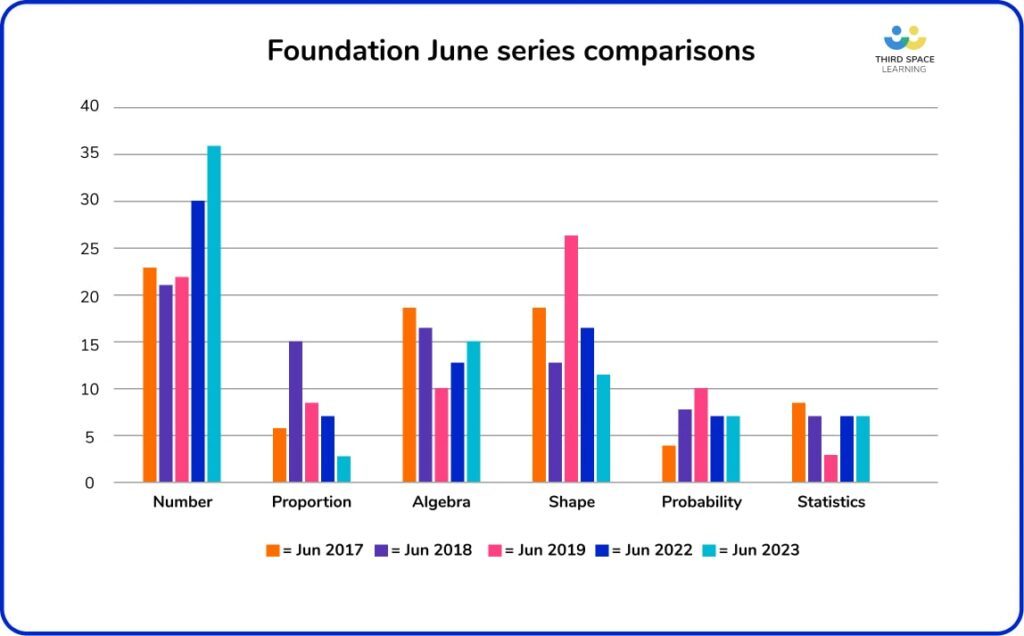
Detailed analysis of Maths Paper 1 Higher 2023
This year’s Higher paper also felt very accessible, with plenty of straightforward content in the paper’s crossover content with Foundation to ease students in.
Topic allocation in Maths Paper 1 (Higher) 2023
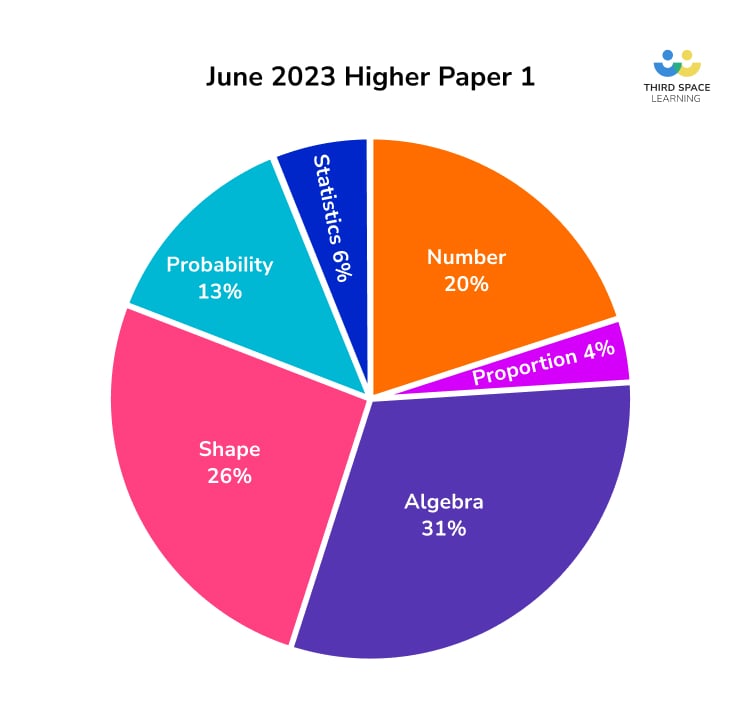
As discussed, some students took umbrage to the paper starting with decimal division, but decimal calculation within the first five questions on Higher isn’t unusual. Of the remaining crossover content, the fraction multiplication, frequency polygon, scatter graph and reverse percentage questions in particular were straightforward and procedural.
Of the topics that only appear on Higher, quite a few questions are directed towards the lower end of the difficulty spectrum – for example, the proportion equation was a simple direct proportion “use these values to find a missing value”, which doesn’t even require writing an equation, whereas on previous series we’ve seen questions requiring candidates to combine two proportion equations, often involving squares or cubes.
The only questions in the Higher only content that included significant amounts of topic embedding or unfamiliar or unusual combinations were
- Q16 – volume of a sphere with fractions and simplifying surds
- Q18 – the infamous carrots and tomatoes question, which involved writing a ratio as a fraction to derive a pair of simultaneous equations
The other high-mark questions contained topic combinations that students would likely have come across in routine exercises of exam preparation – while the question on finding solutions to a pair of quadratic inequalities pulls in a lot of algebra topics (such as factorising and solving quadratics), these are expected and will have been rehearsed within lessons.
Complexity of questions in Maths Paper 1 (Higher) 2023 compared to previous years
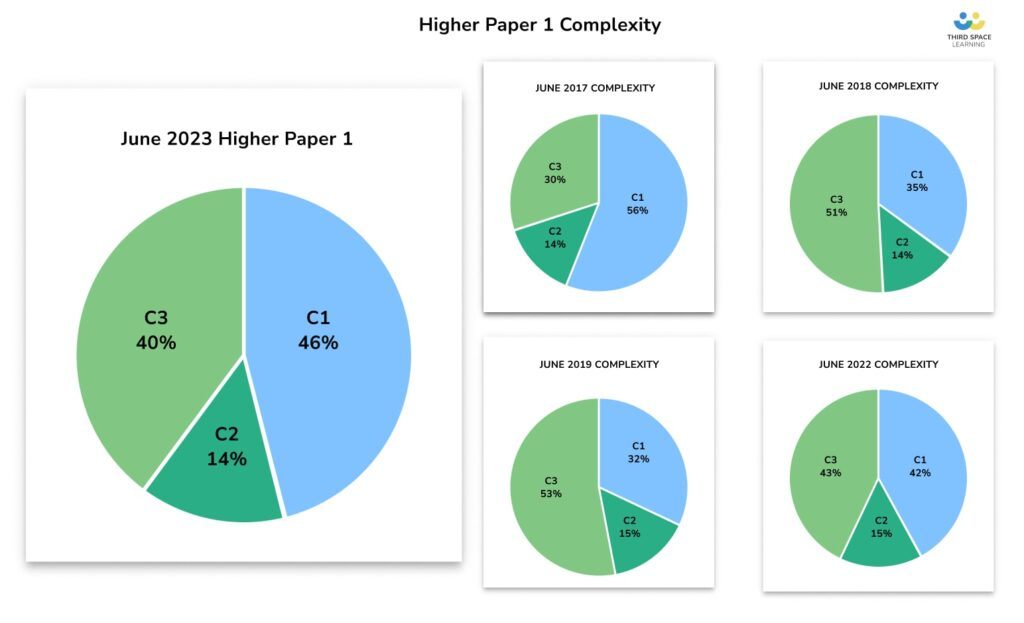
As with Foundation, 2023’s Higher Paper 1 is very similar in complexity to June 2022, which may be reflective of allowances made in exam writing to account for the disruption these cohorts have experienced.
June 2018 and 2019 had a higher ratio of C3 to C1 to questions (over half of the paper). In comparison the two most recent papers sit at around 40% of the marks available on multi-step questions requiring in-depth thinking, problem-solving or applications of several topics.
C2 content is again fairly consistent across summer series. Approximately 15% of the marks on Higher Paper 1 were available for questions involving reasoning, interpreting charts or tables, reading and synthesising information.
Mark allocation for topics in Maths Paper 1 (Higher) 2023 with comparison to previous years
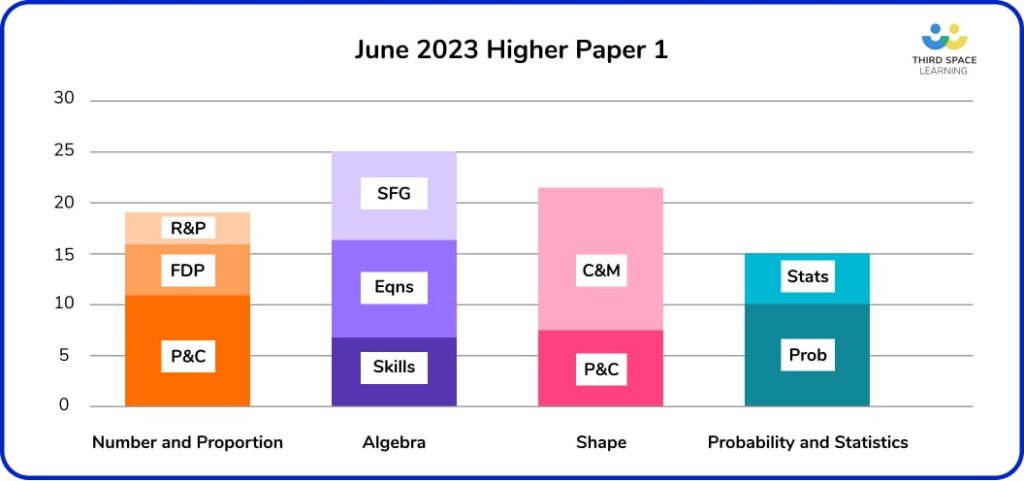
Although the marks available for Number topics (Properties and Calculations, and Fractions, Decimals and Percentages) are within usual variations, Proportion appears unusually low. This may be partially due to this strand not appearing significantly in the crossover content for Paper 1. Again, I think we can expect more on Papers 2 and 3, particularly reasoning or problem solving.
In Algebra, Shape, Probability and Statistics, there is no significant variation from normal patterns. Statistics content is always fairly low on Paper 1 (it tends to get hit harder on Papers 2 and 3, where there is more space for it), so we’ll probably see more of this in the papers to come.
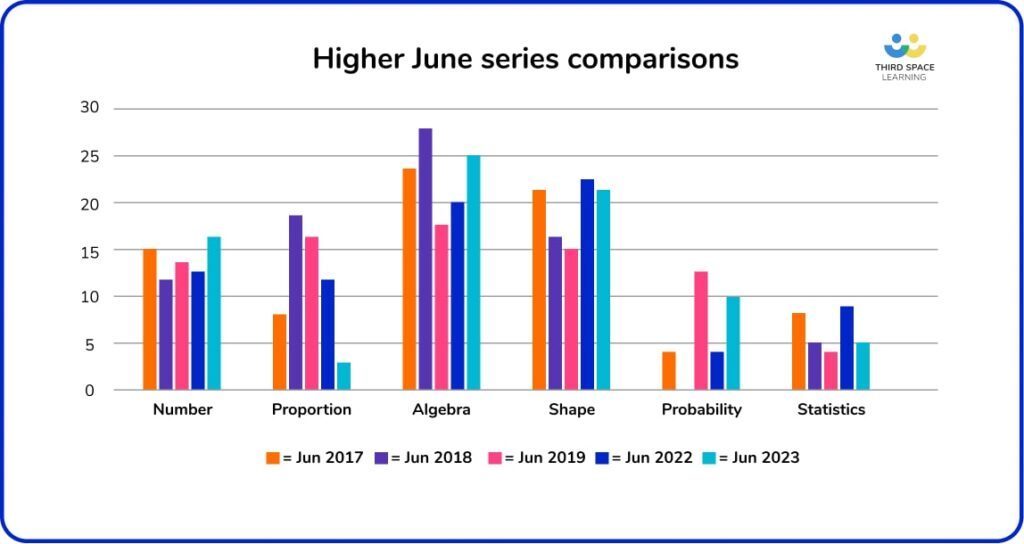
What’s next? Preparing for Papers 2 and 3
As Papers 2 and 3 are both Calculator papers, they are functionally identical with no difference between what can appear on either paper. So any suggestions we’re giving students at this stage apply equally to both of the remaining papers.
The rest of this article looks across the past 4 years’ data we have on both Foundation and Higher summer papers to highlight in more detail how topics and questions have fallen across Papers 1, 2 and 3 and what you might expect to see this year for the remaining papers.
Each section and chart is an attempt to answer a key question that will inform the next stage of your GCSE revision.
Practical revision and exam tips
If, after the first exam you think your students are still struggling with mapping out their revision effectively, then it’s also worth reviewing the guidance and resources available for them here:
‘Calculator topics’ vs ‘Non-Calculator topics’
The nature of some questions and topics mean they are more suited to one or the other – for example, questions where there are marks available for accurate calculation methods, such as fraction arithmetic, are more likely to appear on the Non-Calculator paper. However, it’s worth remembering that such topics could appear on the Calculator papers as a ‘show that’ or ‘spot the mistake’ question, or as an assumed skill for more advanced work.
Topics which don’t require a calculator, such as transformations, constructions, sketching and transforming graphs tend to appear slightly more frequently on the two Calculator papers, just because there is less room for them on the Non-Calculator paper! This skew is more apparent on Higher than Foundation, with the Higher Calculator papers usually containing less explicit work on Number and Proportion, and more on Algebra and Shape.
Question: Which topics have appeared most frequently across all papers?
Topic frequency by paper (Foundation, all previous summer series)
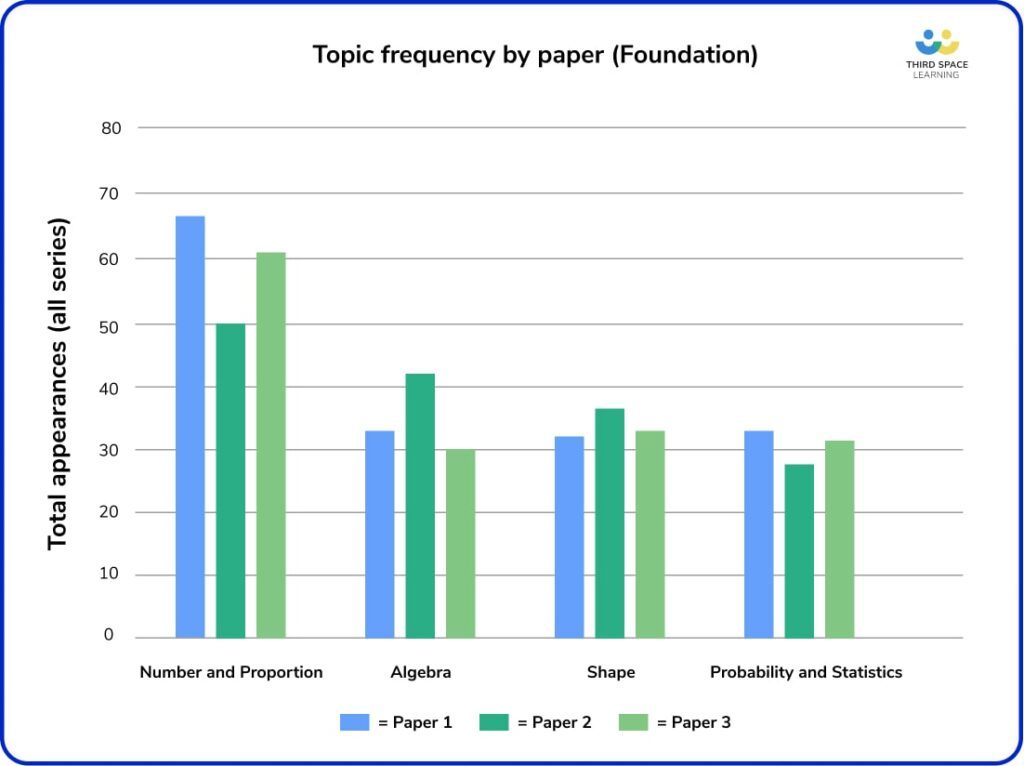
Topic frequency by paper (Higher, all previous summer series)
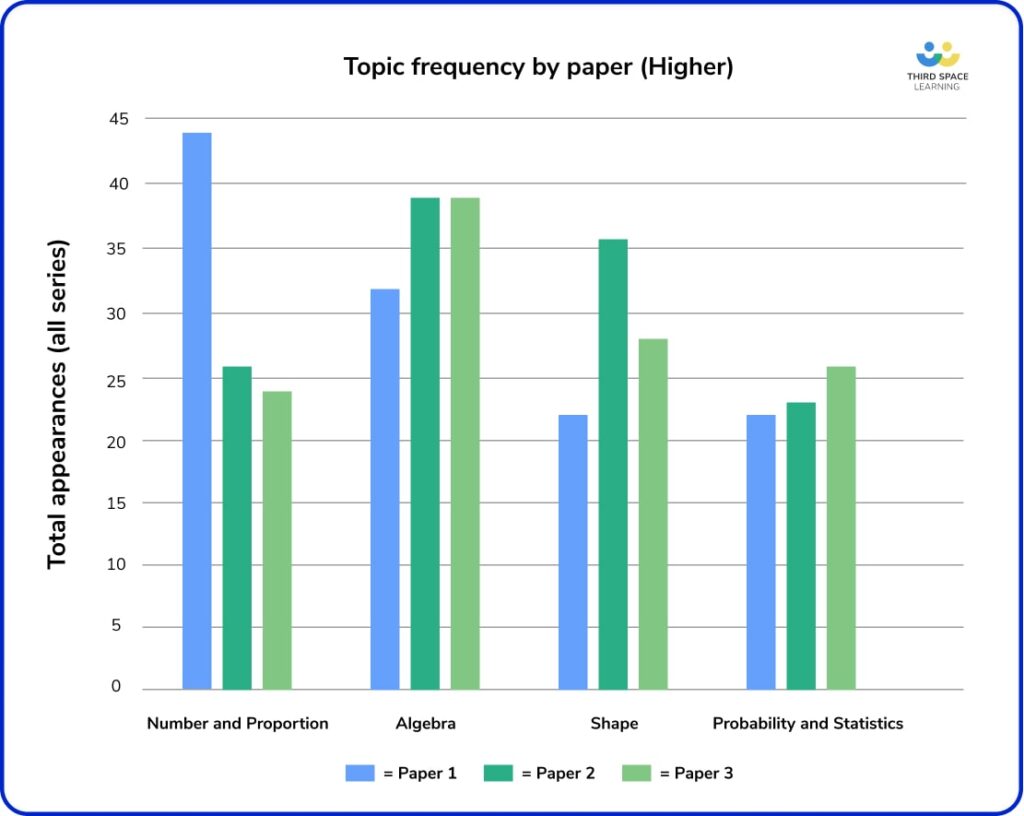
Question: Which topics have appeared most frequently on the Calculator papers?
The topics below have either appeared exclusively on the Calculator papers, or have a significant proportion (< 80%) of appearances on the Calculator papers.
As many of these are traditionally crossover topics, and some have appeared very frequently in the previous four series, it is unlikely that all of the topics listed below will appear in 2023. Italicised topics have appeared on the first paper.
Most frequent Paper 2 and Paper 3 topics (Foundation and Higher)
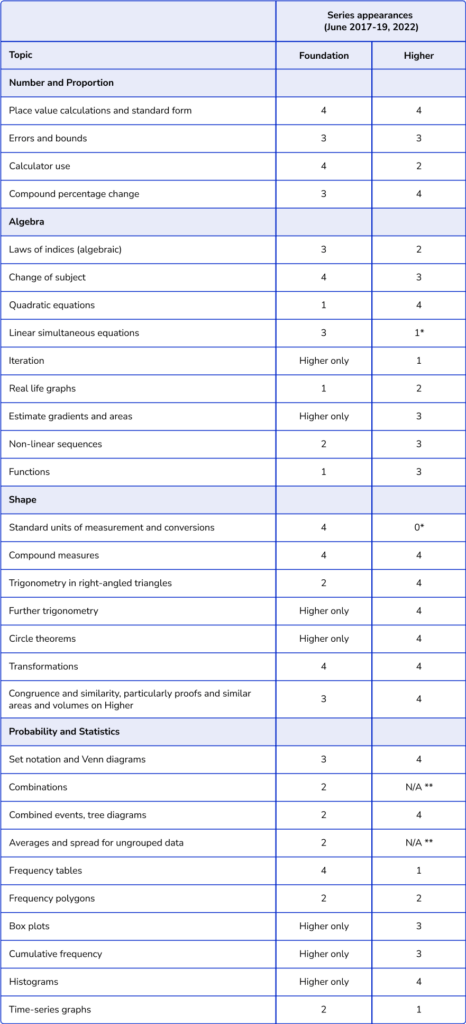
Question: Which topics have appeared on every summer Calculator paper so far?
The topics below have appeared in every series of live summer exam papers (2017-2019, 2022), either on Paper 2 or Paper 3, or both. As such, there’s a reasonable probability that a good proportion of these will come up this year on either of the Calculator papers. Anything relevant to this year’s Paper 1 has been noted in italics.
This would be a good place to start in collating a “general Calculator Paper” practice booklet – there are some suggestions of questions that you could use with students so they know what sorts of things to expect.
25 topics seen on every June series Foundation Maths Paper 2 and Paper 3
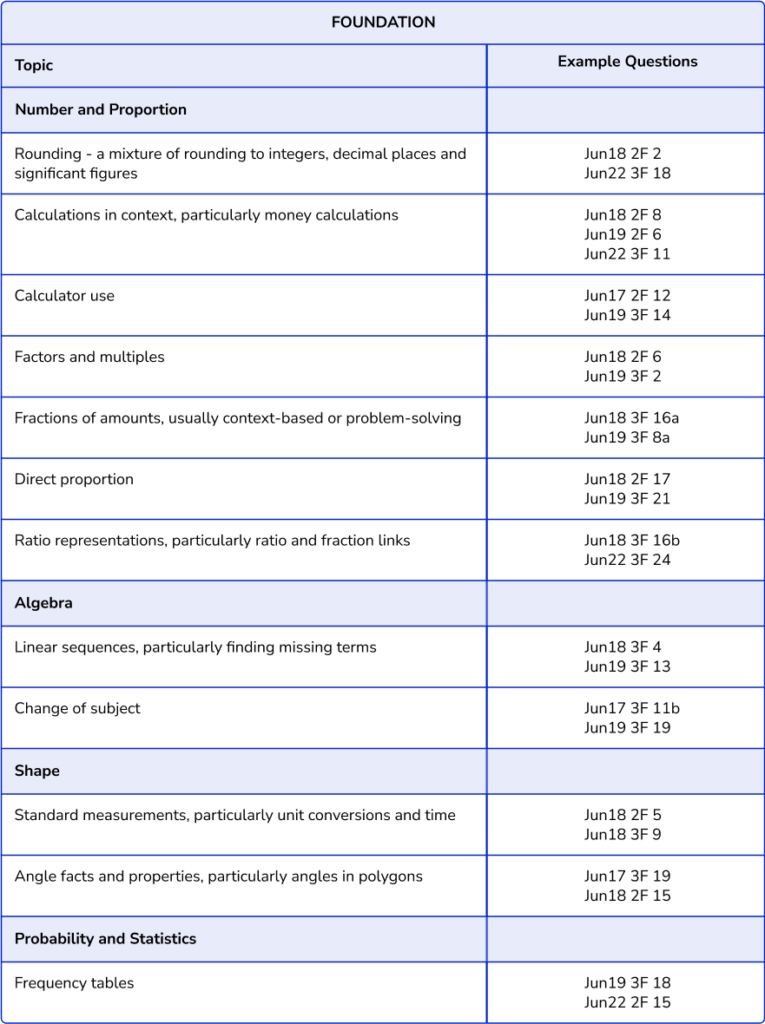
13 topics seen on every June series Higher Maths Paper 2 and Paper 3
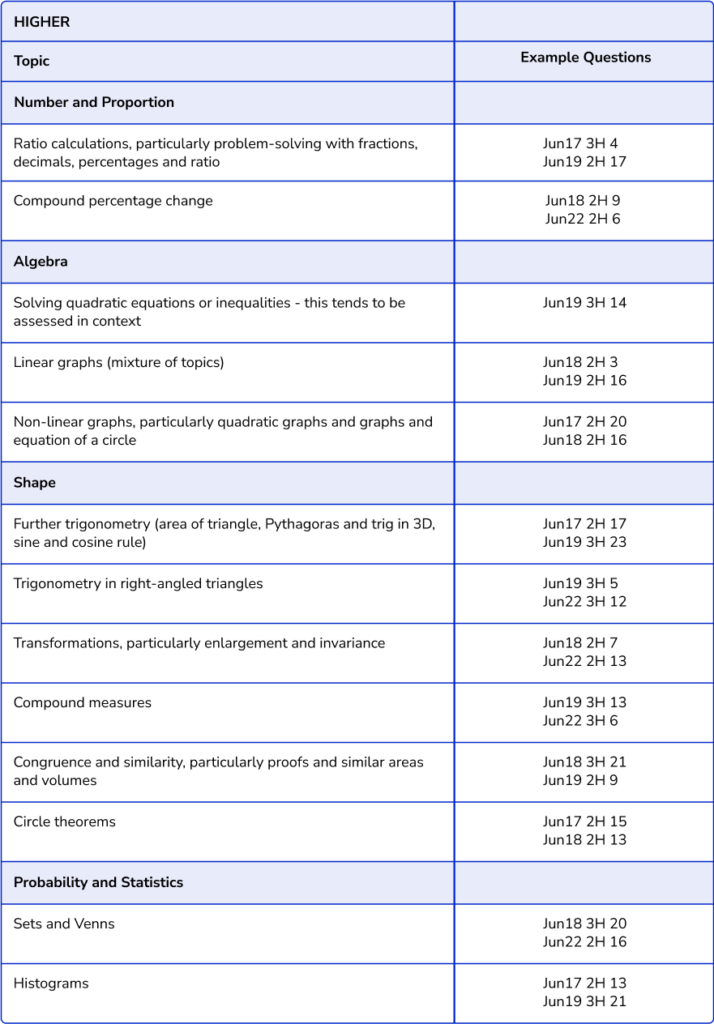
Question: Which Calculator topics haven’t been seen for a while?
This is a selection of topics that have only appeared once on the Calculator papers between 2017 and 2019, and did not appear in the 2022 series. These may be ones to watch out for as less frequently assessed, but perhaps due a turn this year!
Some of these are good topics to hit once students are really confident and fluent with the essentials for each paper – definitely not an area to focus all of their revision. For example, I’d mention to Higher students aiming for grades 8-9 to check their understanding of invariance, as it’s a topic that’s often forgotten, won’t be worth many marks, but may be relevant for those trying to get every possible mark on the paper.
6 topics missing from recent Foundation Papers 2 and 3
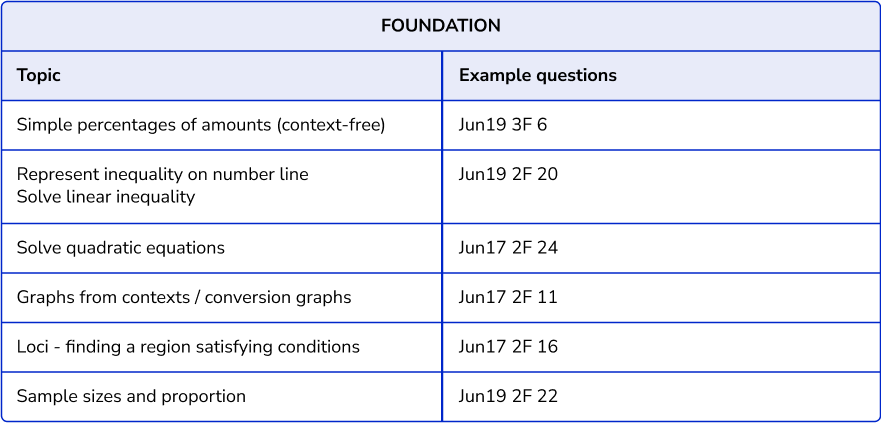
11 topics missing from recent Higher Papers 2 and 3
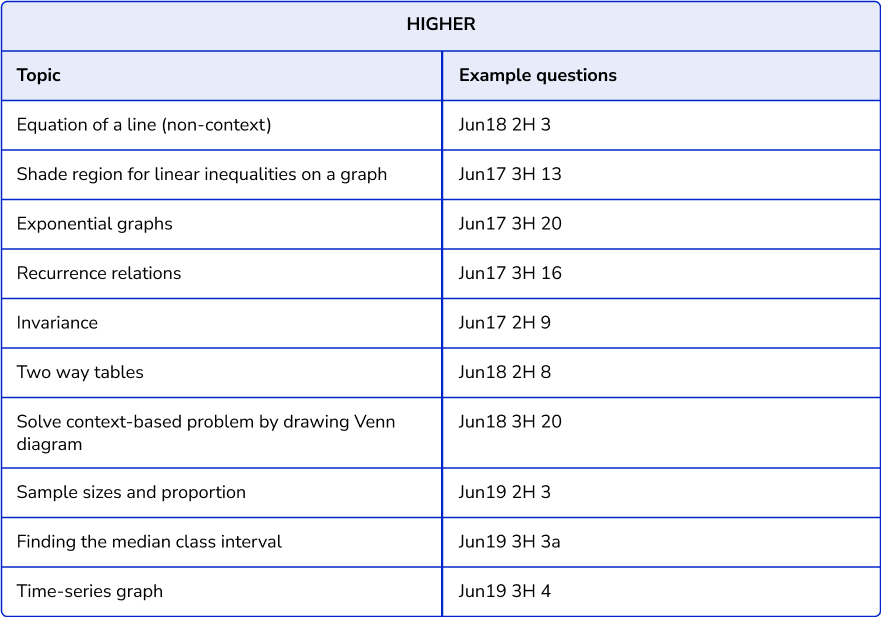
What’s next for your GCSE maths revision
That concludes our analysis so far on the two first maths papers. The dates for the next two GCSE maths papers are:
- Paper 2 – Wednesday 7th June
- Paper 3 – Wednesday 14th June
We’ll be back then with an updated hit-list and some further analysis in between Papers 2 and 3.
The suggested list of topics won’t change significantly between these two papers, but we’ll be able to narrow down our hit-list for Paper 3 once we know how Paper 2 pans out.
Look out for a more in-depth analysis of the series as a whole towards the end of June, when we’ll be thinking about how you can use this year’s exam questions with next year’s cohort and doing some more data-crunching to look at how this series sits in the wider context of previous Edexcel exam papers.
Addendum: Links to the free maths revision guides for all topics in the hit lists above
Foundation tier revision guides
| NUMBER |
| Rounding numbers |
| Money problems maths |
| Calculator skills |
| Error intervals |
| Standard form |
| HCF and LCM |
| Factor Trees |
| Prime factors |
| Percentage change |
| Compound interest |
| RATIO & PROPORTION |
| Proportion |
| Conversion graphs |
| Directly proportional graph / Inversely proportional graph |
| Direct and indirect proportion |
| Metric units of measurement |
| Ratio |
| Speed distance time |
Higher tier revision guides
| NUMBER |
| Calculator skills |
| Upper and lower bounds |
| Error intervals |
| Standard form |
| HCF and LCM |
| Factor Trees |
| Prime factors |
| Percentage change |
| Compound interest |
| RATIO & PROPORTION |
| Proportion |
| Conversion graphs |
| Directly proportional graph/ Inversely proportional graph |
| Direct and indirect proportion |
| Metric units of measurement |
| Ratio |
| Speed distance time |
DO YOU HAVE STUDENTS WHO NEED MORE SUPPORT IN MATHS?
Skye – our AI maths tutor built by teachers – gives students personalised one-to-one lessons that address learning gaps and build confidence.
Since 2013 we’ve taught over 2 million hours of maths lessons to more than 170,000 students to help them become fluent, able mathematicians.
Explore our AI maths tutoring or find out how our GCSE maths tutoring programmes could support students in your school.
